#1920's cinema star
Text

Myrna Loy photographed in the late 1920s by Nickolas Murray
24 notes
·
View notes
Text

A Beagles tinted postcard circa 1920’s.
Caption says “Shoulder Arms”, but image taken from a photo shoot, tramp costume from “A Dog’s Life”.
11 notes
·
View notes
Text
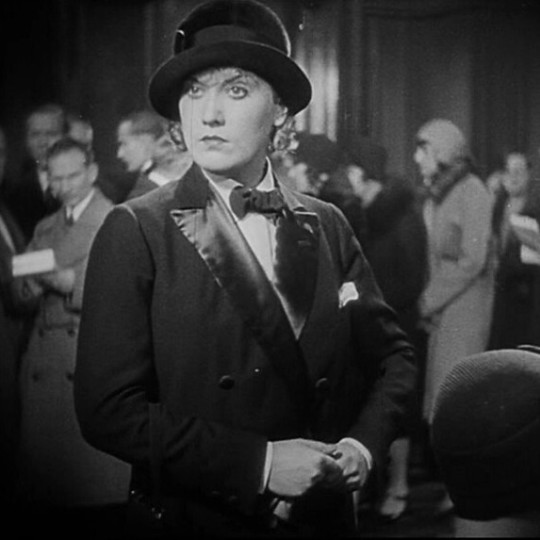
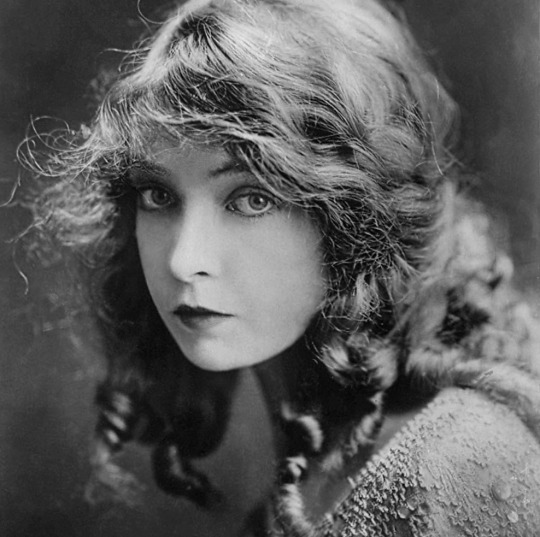
Propaganda
Alice Roberts (Pandora's Box)—I dunno if she was a star per se but she did this groundbreaking lesbian role in a very groundbreaking 1920 movie and she won my heart while doing so. And his 1920's butch style is on pointtt
Lillian Gish (The Wind, Broken Blossoms)—Known as "The First Lady of American Cinema," Lillian Gish was an Academy Award nominated actress that actually began her career as a child actor onstage in theater plays. She was a prominent actress during the silent film era and her ethereal beauty made her one of the most popular actresses of the time/ She was a favorite leading lady of famous director D.W. Griffith, starring in several of his films, including the controversial Birth of a Nation. She was known to go to extremes in preparing for roles, such as sustaining permanent nerve damage in her fingers on one hand after filming a scene in Way Down East where she fainted on an ice floe and kept her hand partially submerged in the frigid water. Her screams during the famous closet scene of Broken Blossoms were supposedly so realistic and horrific that tale has it that bystanders outside the studio had to be stopped from rushing in to help. She is listed on AFI's list of the greatest female stars of classic American Cinema and was awarded several honors during her career.
This is round 1 of the tournament. All other polls in this bracket can be found here. Please reblog with further support of your beloved hot sexy vintage woman.
3/3/2024 EDIT: there has been a lot of discussion on this poll that I'm currently examining. Please read the propaganda carefully and weigh your options before voting.
[additional propaganda submitted under the cut.]
Lillian Gish propaganda:

"I love her just. So so much."
"Was in (arguably) the first movie ever and yeah it was a crap movie but still. Also watch her in Broken Blossoms, man can she ACT (and if an actress is good at her craft it does in fact make me more horny for her)"

"she's literally everything to me i'm not even kidding. quite LITERALLY called the First Lady of American Cinema, she was a damn pioneer of silent movies and acting. she wrote! she directed! she is exactly what i think a fairy would look like actually. she slayed in The Wind. i mean. look at Her"
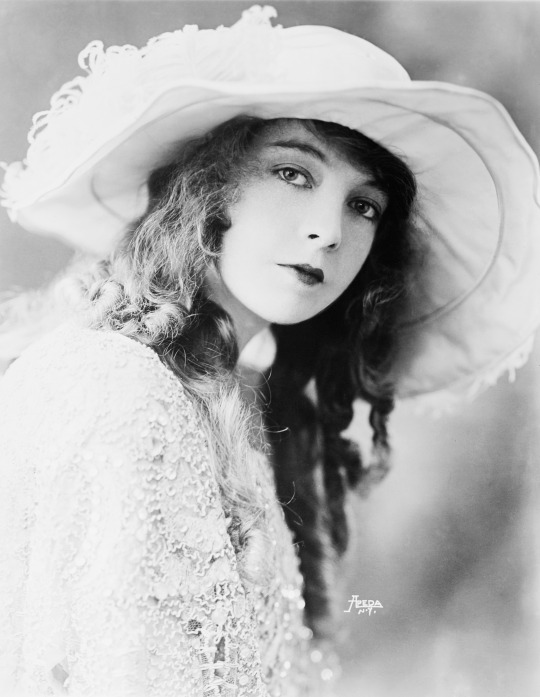
#lillian gish#alice roberts#[editor's note: i would call birth of a nation more than controversial. i would not consider it a career highlight.]#hotvintagepoll#fuck that old woman#ladies 1
191 notes
·
View notes
Text

Movie Odyssey Retrospective
The Phantom of the Opera (1925)
By the time French journalist-turned-novelist Gaston Leroux published Le Fantôme de l'Opéra as a serial in 1909, he was best known for his detective fiction, deeply influenced by Sir Arthur Conan Doyle and Edgar Allan Poe. The Phantom of the Opera plays out like a Poe work – teeming with the macabre, painted with one character’s fanatic, violent lust. In serial form and, later, as a novel, Leroux’s work won praise across the West. One of the book’s many fans was Universal Pictures president Carl Laemmle who, on a 1922 trip to Paris, met with Leroux. While on the trip, he read Phantom (a copy gifted to him by Leroux) in a single night, and bought the film rights with a certain actor already in mind.
Laemmle’s first and only choice for the role of the Phantom was about to play Quasimodo in Universal’s 1923 adaptation of Victor Hugo’s The Hunchback of Notre Dame. That actor, Lon Chaney, had subsisted on bit roles and background parts since entering into a contract with Universal in 1912. Chaney, who was about to sign a contract with Metro-Goldwyn-Mayer (MGM), became an instant sensation the moment The Hunchback of Notre Dame hit theaters. Audiences and critics in the early 1920s were simultaneously horrified at the sight of his Quasimodo yet, crucially, felt a profound empathy towards the character.
In his prior films, as well as Hunchback, Chaney separated himself from his fellow bit actors with a skill that almost no other actor in Hollywood possessed: he was also a makeup artist. At this time, actors applied their own makeup – often simple cosmetics or unconvincing facial hair. None of the major Hollywood studios had makeup departments in the early 1920s, and it would not be until the 1940s that each studio had such a department. Chaney, the son of two deaf and mute adults, was also a master of physical acting, and could expertly use his hands and arms to empower a scene. Though already bound for MGM, Chaney could not possibly pass up the role of Erik, the Phantom. Despite frequent clashes with director Rupert Julian (1923’s Merry-Go-Round and 1930’s The Cat Creeps; despite being Universal’s most acclaimed director at this time, Julian was either sacked or walked away mid-production), Chaney’s performance alone earned him his place in cinematic history and, for this film, an iconic work of horror cinema and silent film.
As the film begins, we find ourselves at the Palais Garnier, home of the Paris Opera. The Opera’s management has resigned, turning over the Palais Garnier to new ownership. As the ink dries on the contract and as the previous owners depart, they warn about a Phantom of the Opera, who likes sitting in one of the box seats. Soon after, prima donna Carlotta (Virginia Pearson) receives a threatening letter from the Phantom. She must step aside and allow a chorus girl, Christine Daaé (Mary Philbin), sing the lead role in Charles Gounod’s Faust. If she refuses to comply, the Phantom promises something horrific. Aware of the letter, Christine the next day confers with her loved one, the Vicomte Raoul de Chagny (Norman Kerry), that she has been receiving musical guidance from a “Spirit of Music”, whom she has heard through the walls of her dressing room. Raoul laughs this off, but a series of murderous incidents at that evening’s production of Faust is no laughing matter. Christine eventually meets the shadowy musical genius of the Phantom, whose name is Erik (Chaney). In his subterranean lair, he professes his love to her – a love that will never die.
Rupert Julian’s The Phantom of the Opera also stars Arthur Edmund Carewe as the Inspector Ledoux (for fans of Andrew Lloyd Webber’s musical version, this is the Madame Giry character); Gibson Gowland as Simon Buquet; and John St. Polis as Raoul’s brother, the Comte Philippe de Chagny.
Before extoling this film, one has to single out Mary Philbin and Norman Kerry as the glaring underperformers in this adaptation. Philbin would become a much better actress than she displays here, if The Man Who Laughs (1928) is any indication. Yet, Philbin’s Christine is a blank slate, devoid of much personality and interest. It also does not help that Norman Kerry plays Raoul in a similar fashion. Raoul, in any adaptation of Phantom, tends to be a boring role. But goodness me, for a B-actor who was acclaimed for his tall, dark, and handsome looks and screen persona, he is a charisma vacuum here. During Kerry’s more intimate scenes with Philbin, you may notice that Kerry has a case of “roving hands” when he gets close with Philbin. Philbin, who could not visibly react to these moments on-camera, surreptitiously took Kerry’s hands and held them there to stop the touching.
Philbin is much better when sharing the screen opposite Chaney. Chaney and Philbin both could not stand director Rupert Julian – whom both actors, as well almost all of the crew, regarded as an imposing fraud who knew little about making art and more about how to cut costs (Laemmle appointed Julian for this film in part due to Julian’s reputation for delivering work under budget). There are unconfirmed accounts that after Julian’s departure or removal from Phantom, Chaney himself directed the remainder of the shoot aside from the final climactic chase scene (which was the uncredited Edward Sedgwick’s responsibility). In any case, Philbin’s terror when around Chaney was real. The sets of the Phantom’s lair reportedly spooked her – the subterranean waterways, his inner sanctum. Philbin also received no preparation before the filming of what is now one of the signature moments of the silent film era and all of horror cinema. Her reaction to Lon Chaney’s self-applied makeup – meant to appear half-skin, half-skeletal – was the first time that she saw Chaney’s Phantom in all his gruesomeness. Philbin, freed of the innocent, pedestrian dialogue of the film’s opening act, gifts to the camera one hell of a reaction, fully fitting within the bounds of silent film horror.
There are conflicting records on how Chaney achieved the Phantom’s final appearance. The descriptions forthcoming are the elements that freely-available scholarship generally accepts as true. It appears that Chaney utilized a skull cap to raise his forehead’s height, as well as marking deep pencil lines onto that cap to accentuate wrinkles and his brow. He also raised his cheekbones by stuffing cotton into his cheeks, as well as placing a set of stylized, decaying dentures. Inner-nasal wiring altered the angle of his nose, and white highlights across his face contributed to his skeletal look for the cameras. Cinematographer Charles Van Enger (1920's The Last of the Mohicans, uncredited on 1925's The Big Parade) – who, other than Chaney, was one of the most familiar onset with Chaney’s makeup – claimed that the nasal wiring sometimes led to significant bleeding. Taking inspiration from Chaney’s approach to keeping the makeup artistry hidden from Philbin and others, Universal kept the Phantom’s true appearance a secret from the public and press. The studio advised movie theaters to keep smelling salts ready, in case of audience members fainting during the unmasking scene. According to popular reporting at the time, audience members did scream and faint upon the reveal; a nine-year-old Gregory Peck’s first movie memory was being so terrified of Lon Chaney’s Phantom, that he asked to sleep with his grandmother that evening after he came home.
youtube
Lon Chaney’s tremendous performance allows The Phantom of the Opera to soar. Arguably, it is his career pinnacle. Masked or unmasked, Chaney’s Phantom dominates the frame at any moment he is onscreen aside from the film’s final chase sequence. Whether glowering over Christine, majestically gesturing in silhouette, strutting down the Opera House steps during the Bal Masqué, or tucked into the corner of the frame, Chaney’s physical presence draws the audience’s eyes to whatever he is doing. The differences in posture from before and after the unmasking scene are striking – from an elegant specter to a broken, hunched figure (appearing to draw some inspiration from his experience playing Quasimodo two years earlier) seething with pent-up carnality, rage, and sorrow. Chaney’s Phantom garners the audience’s sympathy when he gives Christine the grand tour of his chambers. Look at his posture and hands when he mentions, “That is where I sleep,” and, “If I am the Phantom, it is because man’s hatred has made me so.” That Chaney can ease through these transitions and transformations – as well as a third transformation, as the Red Death during the Bal Masqué – so naturally, without a misstep, is a testament to his acting ability.
Underneath the tortured and twisted visage of a man who has committed horrific acts is a vulnerable and misguided human being. His dreams, dashed and discarded by all others, have turned to despicable means. The role of the Phantom plays brilliantly to Chaney’s genius: to have audiences sympathize with even the most despicable or despondent characters he played. Chaney accomplishes this despite this film characterizing the Phantom with less sympathy than Leroux’s original novel and the popular Andrew Lloyd Webber musical.
This is already on top of Charles Van Enger’s camerawork; the sharp editing from a team including Edward Curtiss (1932’s Scarface) Maurice Pivar (1923’s The Hunchback of Notre Dame), Gilmore Walker (1927’s Uncle Tom’s Cabin), and Lois Weber.
Weber, who in 1916 was Universal’s highest-paid director, underwent numerous financial difficulties over that decade. One of Hollywood’s first true auteurs and largely ignored in the history of film until recently, Weber formed her own production company with Universal’s assistance in 1917, off the success of Shoes (1916). Through World War I, Weber’s movies were popular until around the turn of the decade, when her “didactic” filmmaking (a result of her devout Christian upbringing) went out of style. Most visibly among Weber’s financial failures of the early 1920s, The Blot (1921) – a movie that scholars and Weber himself considered her best – flopped in theaters. After two hiatuses from filmmaking in the early 1920s, Weber was brought in to conduct the final bits of editing on The Phantom of the Opera before returning to directing under Universal.
Though none of the film’s production designers were yet to hit their peak, The Phantom of the Opera benefitted from having a soon-to-be all-star art department including James Basevi (1944’s The Song of Bernadette), Cedric Gibbons (almost any and all MGM movies from 1925 onward), and Robert Florey (1932’s Murders in the Rue Morgue). Inspired by designs sketched by French art director Ben Carré, the production design trio spared no expense to bring Carré’s illustrations to life and used the entirety of Universal’s Soundstage 28 to construct all necessary interior sets. The set’s five tiers of seating and vast foyer needed to support several hundred extras. So unlike the customary wooden supports commonplace during the silent era for gargantuan sets, The Phantom of the Opera’s set for the Palais Garnier became the first film set ever to use steel supports planted into concrete. Basevi, Gibbons, and Florey’s work is glorious, with no special effects to supplement the visuals. The seventeen-minute Bal Masqué scene – which was shot in gorgeous two-strip Technicolor (the earliest form of Technicolor, which emphasized greens and reds) – is the most striking of all, unfurling its gaudy magnificence to heights rarely seen in cinema.
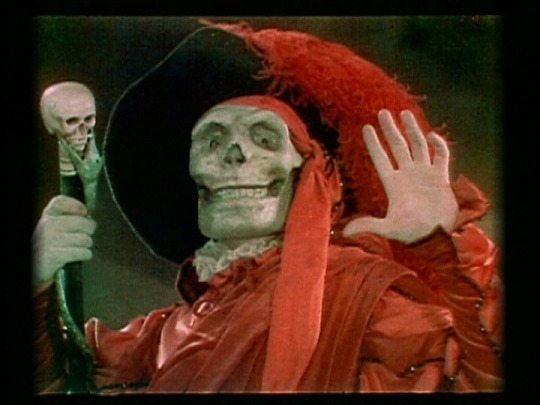
Universal’s Soundstage 28 was an integral part of the VIP tour at Universal Studios Hollywood for decades. Though the orchestra seats and the stage of the film’s Palais Garnier had long gone, the backside box seats of the auditorium remained. Stage 28 featured in numerous films after The Phantom of the Opera, including Dracula (1931), the Lon Chaney biopic Man of a Thousand Faces (1957), Psycho (1960), Charade (1963), Jurassic Park (1993), How the Grinch Stole Christmas (2000), and The Muppets (2011). The soundstage was also supposedly haunted, with individuals claiming to see a caped figure (Lon Chaney as the Phantom?) running around the catwalks, lights flickering on and off, and doors opening and closing on their own. In 2014, after standing for almost ninety years, Universal decided to demolish Stage 28 so as to expand its theme park. However, the historic set escaped the wrecking ball, as Universal decided to disassemble the set, place it into storage, and perhaps someday reassemble it. It is a fate far kinder than almost all other production design relics from the silent era.
Unlike what was coming out of Weimar Germany in the 1920s in the form of German Expressionism, American horror films had no template to follow when The Phantom of the Opera arrived in theaters. There would be no codification of American horror cinema’s tropes and sense of timing until the next decade. But without 1925’s The Phantom of the Opera, Universal would never become the house of horror it did in the 1930s through the early ‘50s (including the Dracula, Frankenstein, Mummy, Invisible Man, Wolf Man, and Creature from the Black Lagoon series). So, unbound by any unwritten guidelines, 1925’s The Phantom of the Opera – a horror film, but arguably also a melodrama with elements of horror – consumes the viewer with its chilling atmosphere and, from Lon Chaney, one of the best cinematic performances ever, without any qualification. For silent film novices, this is one of the best films to begin with (outside the comedies of Charlie Chaplin, Buster Keaton, and Harold Lloyd). Regardless of one’s familiarity with silent film, The Phantom of the Opera is a cinematic milestone.
My rating: 9.5/10
^ Based on my personal imdb rating. My interpretation of that ratings system can be found in the “Ratings system” page on my blog. Half-points are always rounded down.
For more of my reviews tagged “My Movie Odyssey”, check out the tag of the same name on my blog.
This is the twenty-third Movie Odyssey Retrospective. Movie Odyssey Retrospectives are reviews on films I had seen in their entirety before this blog’s creation or films I failed to give a full-length write-up to following the blog’s creation. Previous Retrospectives include Dracula (1931 English-language version), Oliver! (1968), and Peter Pan (1953).
#The Phantom of the Opera#Rupert Julian#Lon Chaney#Mary Philbin#Norman Kerry#Carl Laemmle#Gaston Leroux#Ernst Laemmle#Edward Sedgwick#Arthur Edmund Carewe#Gibson Gowland#Snitz Edwards#Virginia Pearson#Edward Curtiss#Maurice Pivar#Gilmore Walker#Lois Weber#silent film#TCM#My Movie Odyssey
6 notes
·
View notes
Text
The Mosley Review: Babylon

Its been a while since we've had a truly chaotic and whimsical film. A film that doesn't play it safe and goes for the insanity right off the bat. What we really haven't had in a long time is a period film about the massive transitions, hardships and dangers of Hollywood. Its become a niche genre in film that isn't explored as much since the entertainment genre has evolved so much. This film explores the classic period of cinema in the 1920's when silent films were king and the music, fashion, alcohol, opioids and depravity were at its highest peaks. Just the first 20 minutes alone was like a serious fever dream of debauchery, style and fun that was out of this world. They called it the roaring 20's for a reason and this film excels at showing why the era earned its title. Aside from the parties and drugs on tap, you got a fast look at the quick pace of the birth of a star, the growth of a business man, a musician striving for greatness while facing a challenge that is still prevalent today and then a fading of a star. Its so multi-layered and dizzying to explore but in this 3 hour epic, there was plenty of time spent to explore the dark underbelly of the industry and actual character development.

Margot Robbie was absolutely stunning and insanely energetic as rising starlet Nellie LaRoy. The moment she crashes on to the screen she commands the focus. You see LaRoy's meteric climb to fame as she quickly shows off her talents and then the eventual and disturbingly fast cocaine fueled decline. It's a cautionary tale as old as time, but she somehow finds a way to bring out the empathy of the character. Diego Calva was awesome as the film assistant Manny Torres and his journey was something to really focus on as you see the story truly through his eyes from the ground floor. The emotional turmoil the man goes through as he worked so hard to survive not only the assistant life, but also his navigation of the studio system was inspiring and terrifyingly stressful. His chemistry with LaRoy was the heart of the film and yet lacked a lot of logic towards the last half of the film. Anyone else would've stepped away from the chaos, but man did he really hang in there. Brad Pitt was excellent as the arrogant, decadant and never sober movie star Jack Conrad. Pitt truly delivers a strong look at the life of a rock star actor who's earned his status in the industry and yet has never really given up the party life. He is effected the most once the industry begins to shift away from silent films to talkies and to see his reactions was refreshing and classic. Jean Smart was elegant and fun as the journalist Elinor St. John. She may have been around for the debauchery, but she knew what was coming and had a realistic outlook on the world. Li Jun Li was outstanding as the cabaret singer and titles designer Lady Fay Zhu. She was so smooth in her scenes and even though she was not in it for too long, she represented that sexuality and control that Hollywood at the time was not ready for. Jovan Adepo was great as the sensational jazz trumpet player Sidney Palmer. His rise to fame was fun to watch and subtle in execution. I loved how he handled himself as essentially a session musician that got recognized for his talent. The obvious level of racism of Hollywood is explored in this film in one of the most degrading scenes I've ever seen and yet it still happens today, but in digital form. Sidney never forgets his roots and he was truly one of my favorite characters. Tobey Maguire was absolutely weird and terrifying as the truly messed up mob boss James McKay. He was very welcoming, but man his eyes were filled with evil and he takes you into the darkness in the most disturbing scenes of the film.
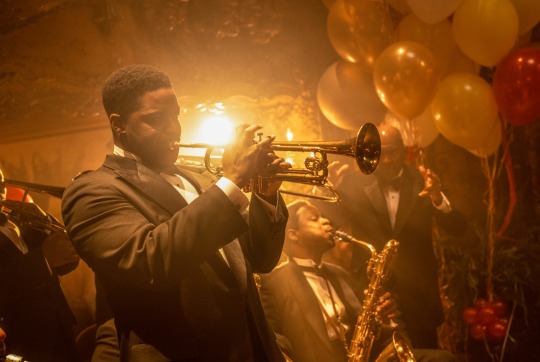
The score by Justin Hurwitz was pure brilliance. It was fun, energetic, chaotic and captured the tone and speed of the film's nonstop pace. Even with its infectious energy coursing through the veins of the film, there were enough moments where it highlighted heart of the film. The cinematography was outstanding and showcased the epic parties and landscapes of the many locations in Los Angeles. Even though the film was a 3 hour epic, I didn't feel the length of the film because of the fast pacing at not many have mastered that technique. There were moments that I think could've been trimmed a bit here and there, but overall I loved the film history lesson. The old saying of life immitading art and art immitading life was on full display in the last 30 minutes of the film and that I enjoyed. This was not only a energetic celebratory look at cinema history, but also a cautionary tale and reminder of how fast your life can change in the entertainment world for the best or the worst. Let me know what you thought of the film or my review in the comments below. Thanks for reading!
#babylon#margot robbie#diego calva#brad pitt#li jun li#jean smart#jovan adepo#tobey maguire#damien chazelle#justin hurwitz
17 notes
·
View notes
Text
BLOGTOBER 10/6/2022 - GOLEMANIA! PT 1: DER GOLEM - HOW HE CAME INTO THE WORLD
For Blogtober 10/6 and 10/7, I examined two films about Jewish mysticism, both made by non-Jews, both long unavailable (or simply not available enough), and both fine examples of the style and visual capabilities of their times.
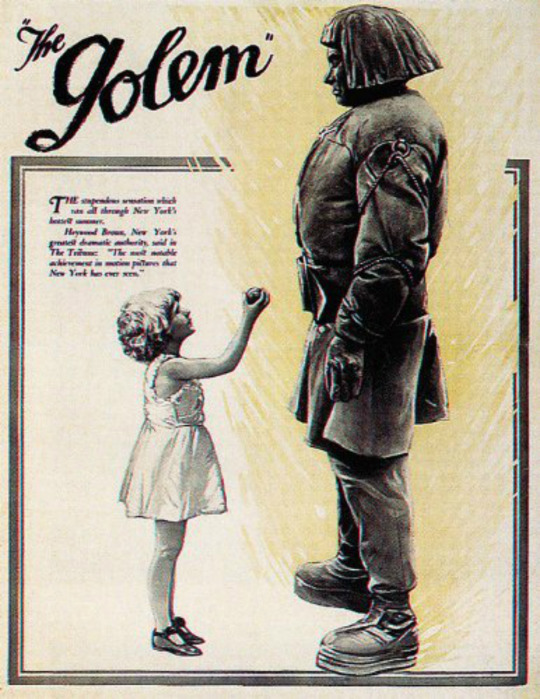
Though THE GOLEM: HOW HE CAME INTO THE WORLD represents an important beat in the development of German expressionist cinema, and any self-respecting nerd has seen plenty of beguiling stills from it, not as many people know it well enough to discuss it on the level that NOSFERATU or THE CABINET OF DR. CALIGARI enjoy. This is surely relatable to availability issues—in fact, the film is part of a trilogy, along with 1915's THE GOLEM and the 1917's THE GOLEM AND THE DANCING GIRL (apparently a primordial example of a horror-comedy!), but these other two are lost to time. The 1920 release, which I'll call DER GOLEM for convenience's sake, is the result of director and star Paul Wegener's desire to update his first effort, which was compromised by a number of disappointing production problems. So, it seems that if we can only have one of his Golem movies, it may as well be this one.
DER GOLEM is the collaboration of writer-director Wegener, his co-writer Henrik Galeen (see also: NOSFERATU), and his co-director Carl Boese, who I assume was especially necessary as Wegener himself plays the title role. The film is adapted from a novel by Austrian author Gustav Myer, which is further based on a Jewish folk tale, and it is interesting to see how this Germanic creative team express their impressions of the history of Jewish persecution. Some critics have found antisemitic underpinnings in the film, largely due to the (delightfully) frightening depiction of the esoteric practice that activates the Golem (which may have a deeper meaning than is immediately apparent), but that would be throwing the baby out with the bathwater. Despite the film being rather brief and broad, it is full of complex, sympathetic characters who transform significantly as the narrative unspools.
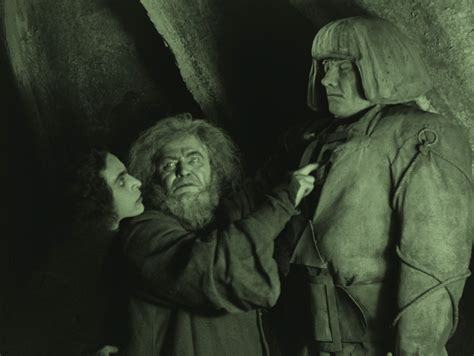
The story takes place in the Jewish ghetto of medieval Prague, where the venerable Rabbi Loew (Albert Steinrück) reads a warning in the stars predicting an imminent danger to his people. Sure enough, an edict comes down from the Holy Roman Emperor (Otto Gebühr) condemning the Jews for their evil character, and ordering their expulsion from the region. Loew creates a hulking clay protector who is brought to life by a sacred word hidden in a star-shaped talisman lodged in his chest, and thinks to impress and entertain the Emperor with his abilities in order to ameliorate the situation. The Golem makes a big splash in the Emperor's court, but the Rabbi's other demonstration doesn't go so well; he implores his audience not to laugh or speak during a magical cinematic projection of the history of the Jewish people, but they can't contain themselves, and the palace begins to crumble. When they are saved by the Golem, the Emperor gratefully rescinds his edict.
Now, this may be enormously crass of me, but I really, deeply think it would be incredibly great if Alamo Drafthouse made one of their pre-show warnings out of this scene. DON'T TALK. DON'T TEXT. OR THE GOLEM WON'T SAVE YOU FROM THE SUPERNATURAL DESTRUCTION OF YOUR EMPIRE.

The other thing I'd like to casually note about this first section, just because it's something I happen to know a little bit about, is that Rabbi Loew's invocation of the goetic demon Astaroth is not really equatable with the idea of devil worship that some viewers have extracted from this—which is fair, because this isn't easy to understand, nor is it readily accessible information. But (and I'm speaking very colloquially here) Astaroth is said to have mastery over esoteric knowledge, and one would work with him in order to gain more occult (for lack of a better word) enlightenment; so, it makes sense that he gives Rabbi Loew the sacred animating word. The other thing about working with demons is that they represent some set of what are usually considered to be negative characteristics: say, slander, wrath, vengeance, etc. So you might work with one of them to deflect these archetypal energies if they are directed at you by someone else. But, you'll also want to be prepared to address these elements in a mature and intelligent way, lest you be overtaken by them yourself. The final effect would be that you've learned an important lesson, and can't be harmed or dominated by whatever malefic characteristic you're dealing with.
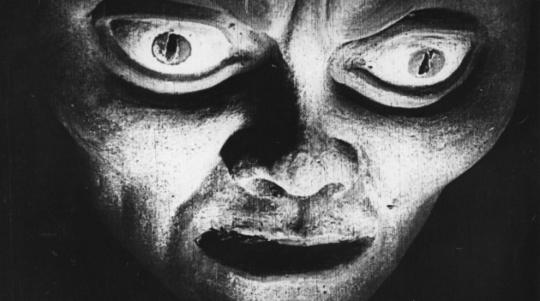
Once the Golem has served its purpose in averting the persecution of the Jews, Loew receives a warning that Astaroth may take it over and use it for vengeful violence. Loew wisely deactivates the creature, but while he goes out to join in communal celebrations, his Assistant makes a big mistake. (The Assistant is played by Ernst Deutsch, a Jewish actor and athlete who I just saw a couple days ago in ISLE OF THE DEAD! I didn't make a note of his wonderful performance as the gently cynical doctor in that film, and now I'm sorry about it) He has fallen in love with the Rabbi's daughter Miriam, and is appalled when he discovers her affair with the Emperor's arrogant squire Florian (Lothar Müthel). The Assistant sets the Golem on Florian, but of course the situation spins out of control, forcing Rabbi Loew to save the community once again.
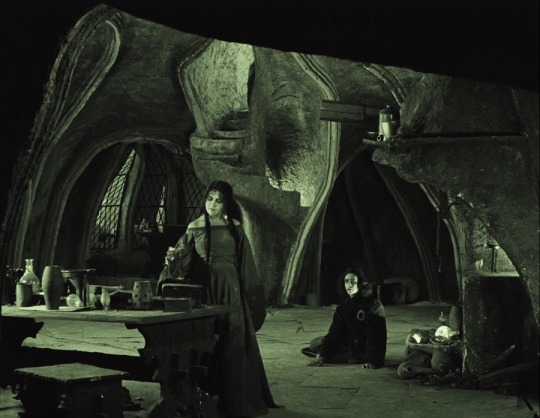
The Golem is an obvious ancestor of Frankenstein's monster, and his misadventure is startlingly similar to that of the better-known creature. Paul Wegener's expressive performance evokes the same range of anger, fear, and naive desire, and his moving interaction with an innocent child is abundantly familiar. In general, DER GOLEM is competitive with FRANKENSTEIN in its emotional complexity; even its villains are tragically human, driven at first by selfish compulsions, but faced with the consequences of their actions, they are sincerely penitent. Even the basics of antisemitism are addressed handily in the film, as the Jews' spartan existence in the ghetto, where their greatest treasures are their traditions and sense of community, flies in the face of the Emperor's accusation that they are avaricious and materialistic. (This coming down from a man bedecked in finery sitting on a gleaming throne, naturally)
The principle gift of DER GOLEM is its advanced aesthetics, owing to the fine work of master cinematographer Karl Freund and architect Hans Poelzig. But the film is bigger than its contributions to film history, telling a sensitive tale that is still surprising in its depth and thoughtfulness. I was glad to see there are new blu ray releases of the film from the last few years, and I'm excited to get my hands on one.

#blogtober#blogtober 2022#golemania#the golem: how he came into the world#der golem: wie er in die Welt kam#paul wegener#carl boese#karl freund#henrik galeen#gustav myer#Albert Steinrück#Otto Gebühr#Ernst Deutsch#Lyda Salmonova#horror#folk horror#german expressionism#hans poelzig#supernatural#occult#esoterism#frankenstein#religion
8 notes
·
View notes
Text

Jeanne Roques (23 February 1889 – 11 December 1957), known professionally as Musidora, was a French actress, film director, and writer. She is best known for her acting in silent films, and rose to public attention for roles in the Louis Feuillade serials Les Vampires as Irma Vep and in Judex as Marie Verdier.
Born Jeanne Roques to music composer and theorist of socialism Jacques Roques and painter and feminist Adèle Porchez, Musidora began her career in the arts at an early age, writing her first novel at the age of fifteen and acting on the stage with the likes of Colette, one of her lifelong friends. During the very early years of French cinema Musidora began a professional collaboration with the highly successful French film director Louis Feuillade. She made her film debut in Les miseres de l'aiguille, directed by Raphael Clamour, in January 1914. The film highlights the problems of the urban women in the French working-class, and presents a new representation of the female even by the working-class movement in the early 20th century in France.
Adopting the moniker of Musidora (Greek for "gift of the muses"), after the heroine in Théophile Gautier's novel Fortunio, and affecting a unique vamp persona that would be popularized in the United States by actress Theda Bara at about the same time, Musidora soon found a foothold in the nascent medium of moving pictures. With her heavily kohled dark eyes, somewhat sinister make-up, pale skin and exotic wardrobes, Musidora quickly became a highly popular and instantly recognizable presence of European cinema.
Beginning in 1915, Musidora began appearing in the successful Feuillade-directed serial Les Vampires as Irma Vep (an anagram of "vampire"), a cabaret singer, opposite Édouard Mathé. Contrary to the title, Les Vampires was not actually about vampires, but about a criminal-gang-run-secret-society inspired by the exploits of the real-life Bonnot Gang. Vep, besides playing a leading role in the Vampires' crimes, also spends two episodes under the hypnotic control of Moreno, a rival criminal who makes her his lover and induces her to assassinate the Grand Vampire.
The series was an immediate success with French cinema-goers and ran in 10 installments until 1916. After the Les Vampires serial, Musidora starred as adventuress, Diana Monti (aka governess "Marie Verdier") in Judex, another popular Feuillade serial filmed in 1916 but delayed for release until 1917. Though not intended to be avant-garde, Les Vampires and Judex were lauded by Louis Aragon and Andre Breton in the 1920s for the films' elements of surprise, fantasy/science fiction, unexpected juxtapositions and visual non sequiturs. Filmmakers Fritz Lang, Luis Buñuel, Georges Franju, Alain Resnais, and Olivier Assayas have cited Les Vampires and Judex as influencing them in their desires to become directors.
At a time when many women in the film industry were relegated to acting, Musidora achieved a degree of success as a producer and director. Musidora became a film producer and director under the tutelage of her mentor, Louis Feuillade. Between the late 1910s and early 1920s, she directed ten films, all of which are lost with the exception of two: 1922's Soleil et Ombre and 1924's La Terre des Taureaux, both of which were filmed in Spain. In Italy, she produced and directed La Flamme Cachee based on the work of her friend Colette. In the same year, she co-wrote (with Colette) and co-directed (with Eugenio Perego) La vagabonda based on Colette's novel of the same name.
After her career as an actress faded, she focused on writing and producing. Her last film was an homage to her mentor Feuillade titled La Magique Image in 1950, which she both directed and starred in. Late in her life, she would occasionally work in the ticket booth of the Cinémathèque Française—few patrons realized that the older woman in the foyer might be starring in the film they were watching.
Musidora died in Paris in 1957 and was buried in the Cimetière de Bois-le-Roi.
14 notes
·
View notes
Text
Babylon (2022) Review
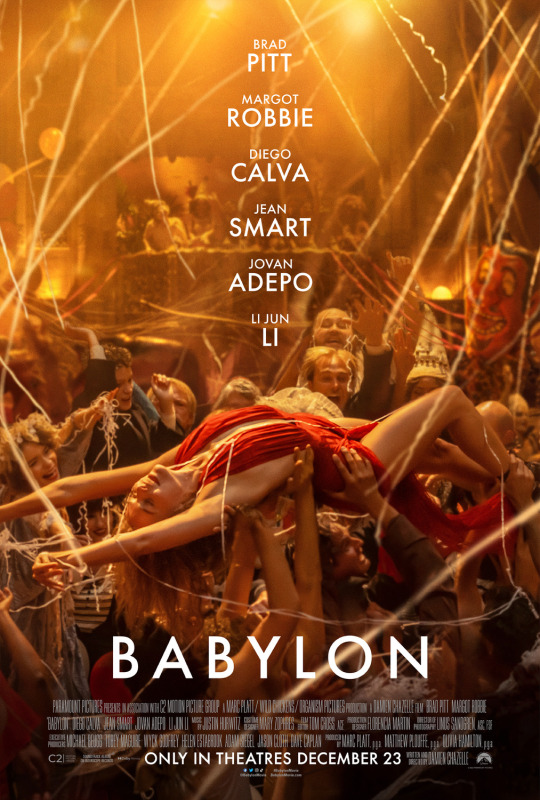
Internet can rejoice - we have finally been given the full scale Hollywood treatment for the famous ‘Bully Maguire’ meme. What a time to be alive!
Plot: A tale of outsized ambition and outrageous excess, it traces the rise and fall of multiple characters during an era of unbridled decadence and depravity in early Hollywood.
So far I have enjoyed everything that director Damien Chazelle had to offer. Whiplash was thrilling and suspenseful; La La Land was my favourite film of that year; and First Man managed to make a Neil Armstrong movie stand out from generic biopic tropes. So of course I was going to see his new Babylon movie, even though I was well aware of the mixed critical and audience responses to it. Having now seen it, I must say its a shame that film will go down as “that 2022 box office flop that starred Brad Pitt and Margot Robbie”. For though its far from perfect, Babylon is a very entertaining movie and one that offers a lot to analyse for those who love cinema. But let’s elaborate...
From the opening scene you can tell that this movie is going to be a raunchy chaotic cascade of Hollywood elites’ debauchery. For better or worse, in the first 5 minutes you get to enjoy an elephant defecate right onto the camera in unnecessary detail, and then 5 minutes later there’s a woman urinating on an oversized naked man who may or may not be Brendan Fraser from The Whale. Yes, it’s that kind of movie, no strings attached so to speak. There’s plenty of grotesque imagery involved, and it’s basically The Wolf of Wall Street set in Hollywood, only with less cussing yet just as much sex. It’s a very energetic movie, that never really takes a moment to breathe and instead just keeps slapping the audience in the face with chaos upon chaos upon chaos for over 3 hours. And yes, this movie is 3 hours long and you feel it. However within all this madness there is an underlining message of the ever-growing nature of cinema, celebrating its longevity and influence through the many changes that it faces. Its the idea that even though, according to Chazelle, Hollywood is the modern day Babylon aka the city of sin, through all the partying and vulgar behaviour all these people together are part of something bigger than all of them, something important. Brad Pitt’s character passionately argues about the movies being “fine art”, and that message comes across strongly in this movie. And yes, through all the mess this is actually a very good looking movie. The set pieces and costume design are all on another level. There’s so much colour and glamour in every scene, and also the score, we need to talk about the music!
Chazelle is no stranger to music, and manages to again include a lot of jazz and trumpets throughout Babylon. He once again has Justin Hurwitz doing the music, and the score plays a major part in supporting the many ongoing themes of the film. There are the tender romantic notes of ‘Manny and Nellie’s Theme’ to the maddening trumping trumpets of Voodoo Mama during the hectic partying set pieces, and then the blending of Hurwitz score with the orchestral classic of Mussorgsky’s “Night on Bald Mountain” during the movie’s look at 1920′s roaring film sets, symbolising, again, the mayhem and disarray of it all. And then there’s Li Jun Li singing songs about the female genitalia, cause, you, city of sin and all that. My point is though the music really amplified the atmosphere and honestly I’ll happily listen to the score outside of the film also, it’s that good.
The performances are all great of course too. Margot Robbie plays the American Dream-obsessed self absorbed starlet well, and Robbie throws herself into all the bedlam that Chazelle gives her, and Brad Pitt....well, I mean its Brad Pitt. You know what you get from the guy. Always solid and reliable and damn cool. Diego Calva is the only character that you can somewhat sympathise with and want to follow, as he’s the only one apparently in this version of Hollywood that isn’t a total prick. Calva does well being the eyes of the audience. We also have a load of other character fly by. From the many wives of Brad Pitt’s character played by the likes of Olivia Wilde and Katherine Waterston, to Jean Smart’s Hollywood writer/critic/gossip columnist who mockingly observes from afar the rise and fall of these people, to the aforementioned Tobey Maguire playing a giggling creepy mob boss, who is very over the top and has really ugly teeth, but again, for internet fans of ‘Bully Maguire’ this one’s a real treat. That being said, Maguire’s role is slightly more than a cameo, and also his part felt like it was part of a completely different movie. His section is very good and entertaining to watch, but again brings me to my main issue with the film...
Where Babylon falls short is in its ambition. It tries to tell so many stories all at once, as such making its central theme of chaos be also a detriment to the movie as a whole. It feels all over the place and as an audience member it becomes difficult to get attached to any specific narrative thread. Also through all the orgies, drug use, dancing and partying, I must say some of the raunchiness was definitely unnecessary and done for the sake of. Like say the elephant pooping or when Robbie’s character projectile vomits all over another person. Those parts didn’t add to anything and felt like Chazelle was seeing how much he could get away with. Also, I appreciate all the love for cinema, but at times this movie felt really pretentious and full of itself. The 1952 Singin’ in the Rain film plays a major ongoing part in this movie, and at the end Calva’s character is sitting in a movie theatre watching that film. Chazelle then proceeds to give us a montage of how cinema progresses through the years right up to modern day, and that felt overly indulgent. Like we get the message - cinema is art. No need to knock us over the head with it.
Babylon is an overstuffed and exhausting movie that at 3 hours is way too long. However its full of entertaining moments and great performances, and you’ll never find yourself bored. If you like The Wolf of Wall Street at 1920s Hollywood, then this one is for you. If you like seeing animals taking massive dumps, well then brother you’re about to watch the best movie of your entire life!
Overall score: 7/10

#babylon#damien chazelle#brad pitt#margot robbie#diego calva#2022#2022 in film#2022 films#justin hurwitz#babylon review#babylon 2022#movie reviews#film reviews#movie#film#cinema#tobey maguire#jean smart#jovan adepo#li jun li#comedy#drama#history#music#hollywood#katherine waterston#olivia wilde#samara weaving#spike jonze#flea
6 notes
·
View notes
Text
shining star: juano hernández - an analysis
“Hernandez is the ‘new Negro’ in our movies. No longer do we have janitor and shoe shine boys. Now, we have a dignified, intelligent black man.”
– director Michael Curtiz, talking about Juano Hernández
Only, he wasn’t black. From José Ferrer to Benicio del Toro, over the years Puerto Rican actors have helped carve out an important space for Latino stars in Hollywood, with Ferrer holding the distinction of being the first Hispanic actor to win an Academy Award for 1950’s Cyrano de Bergerac. But few may know that one of the most influential and critically acclaimed Puerto Rican actors in the history of Hollywood was actually a man of colour, Juano Hernández, whose career in the pictures predated that of Ferrer by over twenty years. Largely forgotten even in his native Puerto Rico, Hernández is considered by film historians to be a trailblazing actor who revolutionized the representation of black characters on the big screen. Hernández was an acting pioneer who paved the way for many of today’s Afro-Latino actors. On radio, Hernández had a career akin to Latino actors in Hollywood cinema, meaning that he played a variety of ethnic roles, usually sidekicks in serials. On stage and screen, however, skin colour restricted Hernández to non-Latino black roles. A true Cancer, Hernández embodied a pride and an eloquence that made it hard to take your eyes off him, from the crinkle of his brow to how he moved with rough-hewn and quiet, dignified grace. But paradoxically, it was because of this quiet Cancerian understatement, class, and dignity that he was overlooked; he wasn’t flashy or a woman noted for her looks, so he wasn’t spoken about fervently or exalted like marquee black star Dorothy Dandridge. His story is so fascinating that a biopic would be worthwhile.
Juano was a stage actor who went on to have a short but meaningful career in 1950s and 1960s Hollywood cinema. Juano gave many indelible performances. — Famed for his big, sympathetic eyes, commanding voice, and incomparable stage presence, Hernández’s eventual mainstream success came with the film Intruder in the Dust, which earned him a Golden Globe nomination. Throughout his 50-year career, Juano racked up a total of 36 TV and film credits, two nominations and garnered the respect of actors both past and present. Though he “starred” (played lead or major supporting roles) in them, the films didn’t turn Juano Hernández into a bankable movie star. He also didn’t get a glamorous “star treatment” in movie magazines or when photographed in films. While non-stereotypical opportunities in Hollywood were few, it’s important to remember that prospects for black actors in Latin American cinema were limited too. Instead, Hernández became an admired and respected character actor whose performances of dignified black masculinity paved the way for younger black actors who achieved full stardom, most notably Sidney Poitier. Before Hernández, the most popular black performers in Hollywood were comedians Stepin Fetchit and Eddie “Rochester” Anderson. Their performances could be sources of embarrassment, but they turned them into box-office attractions. Hernández’s dignified approach, on the other hand, earned him the respect of critics and peers. Juano Hernández’s work on film, television, radio and stage remains criminally largely unknown and awaits a critical reappraisal that is informed by scholarly work on race and gender in transnational media.
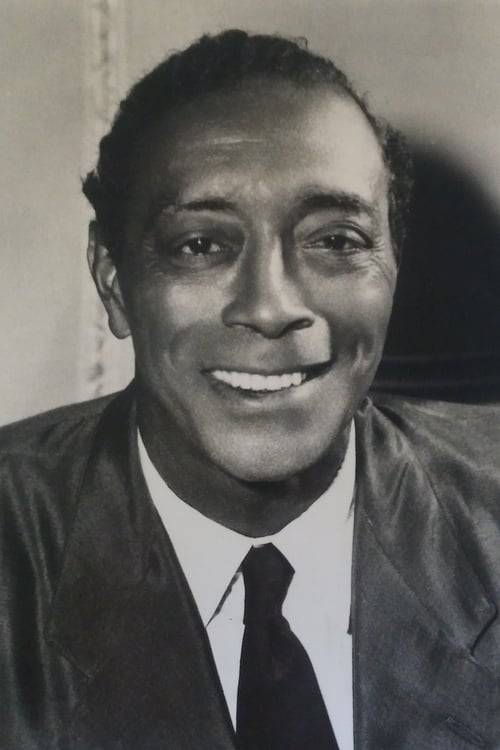
Juano Hernández, according to astrotheme, was a Cancer sun and Scorpio moon (the moon is speculative). He was born Juan G. Hernández in Puerto Rico. Raised in Brazil, Hernández arrived in the United States as a teenager. Details about his early years in the US are unclear. First he became a sailor, then he moved to Rio de Janeiro to work as a carnival performer in 1922. He was also an amateur boxer in the Caribbean nicknamed Kid Curley before joining the vaudeville circuit. By the late 1920s, he had worked his way up to parts in all-black Broadway revues, including Blackbirds, a show that briefly took him to Paris in 1929. He read Shakespeare as much as he could to improve his diction, afraid that his strong Spanish accent would prevent him from getting a good role. But it didn't. Back in the US, Hernández became known for his work on radio. His big break came in early 1933 with John Henry, a CBS series about a mythical dark-skinned strongman from the Mississippi country. Hernández starred, co-scripted, composed the theme song and directed the atmospheric “Negro folk songs.” In the 1930s and 40s, Hernandez became one of the few black radio performers whose career wasn’t restricted to playing demeaning roles, though at least once he faced criticism for accepting an “Uncle Tom role” rejected by another actor. He made his screen debut in Oscar Micheaux’s The Girl from Chicago (1932), a low-budget movie for black audiences with an all-black cast. Hernandez played Cuban gangster Gomez, his only black Latino role in films. Hernandez didn’t return to movies until Intruder in the Dust. Despite an acclaimed introduction to studio films, Juano Hernandez didn’t make many movies during 1950s and 60s. On May 1950, after filming The Breaking Point, the self-taught actor received an honorary doctorate from the University of Puerto Rico and accepted an offer to teach at its Drama and English departments. After spending most of his life abroad, Hernandez moved back to the island and remained based there during his last two decades.
Towards the end of his life, Hernández returned to Puerto Rico and began writing a screenplay based on the story of Sixto Escobar, the island's first boxing champion. Sadly, he did not sell the film to any studio The San Juan, Puerto Rico, native passed away from a cerebral hemorrhage in July of 1970, two days before his birthday, leaving behind an incredible film legacy that broke barriers within the entertainment industry. He was 74. In 2017, Hernández was posthumously honored at Paseo de la Fama (The Walk of Fame) in San Juan.
Next, I’ll switch gears and cover a very famous and iconic entertainer: Gemini Jospehine Baker.

STATS
birthdate: July 19, 1896*
*note*: due to the absence of a birth time, this analysis will be even more speculative
major planets:
Sun: Cancer
Moon: Scorpio
Rising: unknown
Mercury: Cancer
Venus: Leo
Mars: Taurus
Midheaven: unknown
Jupiter: Leo
Saturn: Scorpio
Uranus: Scorpio
Neptune: Gemini
Pluto: Gemini
Overall personality snapshot: He was brooding emotion incarnate, very subjective in his outlook, a trifle overprotective and suspicious, and fully confident that his intellect and perceptive powers would enable him to make rapid progress on the upward path. Tenacious determination to prove himself and secure the dignity and position he felt he merited made him often appear formidable, proud and haughty. But whilst he was capable of going great lengths not only to survive but to win, there really was not an unkind cell in his body. He genuinely cared about his world and the people in it, and his humanity was strong and potent, reaching out to help and transform the darker corners of human existence. If he was part of the establishment he would defend it to the death. If he was an outsider he would attempt to probe into every social assumption and reveal the truth behind the façade, the mysterious behind every commonplace occurrence. The secret and emotional were everything. He loved suspense and mystery, and was drawn to understanding and grappling with the dark side of life, the inordinate and the ugly, in order to see the redeemable, transforming spark of life that lies behind it.
Deeply fascinated by what makes people tick, he had something of the detective and the psychoanalyst in him, which could manifest powerfully in medical or psychological work. But even if he did not have a career, a part of her would always be preoccupied with hidden realities and creatures from ‘inner space’. He guarded his own inner space with great vigilance, and he likewise respected other people’s privacy. He truly came alive, however, when he had been entrusted with a secret or given a search warrant to look inside a troubled mind (or bank account). All his analytical powers became concentrated and uplifted by his reverential, single-minded, determined attitude to discover the truth. He was unafraid of the dark and undaunted by the truth. He worked in a healing profession, and he brought a genuine caring concern and gentle intensity to those ailing in a psychotic underworld. He contributed the love and wisdom of the tender mother together with the exacting discipline of the doctor or policeman. Under his scrutiny and guardianship all his creative projects would have flourished, whatever they may have been. He had the temperament of a fanatic (as do most outstanding artists!) so he needed to try to loosen up a bit and learn to let go.
He had a very good memory and found it easy to learn subjects that interested him. He was very kind and thoughtful towards others. His imagination was very keen, but if it got carried away, he may have experienced irrational fears. Even though he may have tried to maintain a scientific and objective outlook, his mind was actually dominated by his emotions. He was very perceptive, intuitive and compassionate. If he felt threatened or challenged, he tended to withdraw and say little. However, if he was further provoked, he had plenty to say. He used every opportunity he could to show others what he could do. Because he was eager and creative in exploiting his potential, his development and progress was reasonably fast compared to others. Luxury and pleasure attracted him, as did all forms of pomp and ceremony. He could be autocratic at times, but he possessed a genuine desire to please others. One thing that turned him off was when people lacked the strength to stand their ground when they were in the right. He expected a lot from those who are close to him, but he gave a lot too if he felt they were loyal. His attitudes and ideas tended to be on the conservative side, but they were profound and he was able to constructively develop and apply them. He was very serious about everything that gained his attention, although high nervous tension plunged him into periods of depression. His sense of humour tended to be rather black and low-key.
He was part of a generation that was more honest about subjects such as death, sex and the spiritual continuity of life. As such, he wasn’t afraid to ask questions, because he wasn’t afraid of the answers he might received. As a member of this generation, he tended to have an all or nothing personality with powerful emotions seething just below the surface. He was capable of ignoring and suppressing slights and injustices which were bound to eventually resurface. As a member of the Gemini Neptune generation, his restless mind pushed him to explore new intellectual fields. He loved communication and the occult and was likely also fascinated by metaphysical phenomena and astrology. As a Gemini Plutonian, he was mentally restless and willing to examine and change old doctrines, ideas and ways of thinking. As a member of this generation, he showed an enormous amount of mental vitality, originality and perception. Traditional customs and taboos were examined and rejected for newer and more original ways of doing things. As opportunities with education expanded, he questioned more and learned more. As a member of this generation, having more than one occupation at a time would not have been unusual to him.
Love/sex life: He was too demonstrative a lover with too much of an appreciation for drama and display in his love life to keep it completely secret. And, typically, he was having too much fun to care. He was a boisterous, fiery Taurean Martian lover: warm-hearted, generous and profoundly sensual. He had a taste for the unusual in his sexual experiences and bragging rights mattered as much as sensation. The conservative side of his sexual nature often showed itself most in his need for control. Sex lost its appeal for him the minute he felt he was being forced to play by someone else’s rules. There was nothing fancy in his need to control his own sex life. He had no taste for psychological manipulation. He just liked to be the person who said where, when, and how the relationship was going to progress. Even if he wasn’t the person in control, he liked it understood that he could be. Anyone willing to live by these rules found him a very compliant lover.
minor asteroids and points:
North Node: Aquarius
Lilith: Aries
His North Node in Capricorn dictated that he needed to try not to let himself fall in the trap of overemphasizing his own importance. He needed to be able to share with others more readily and to be prepared to see issues from their perspective. His Lilith in Aries ensured that he was dangerously attracted to women who used sex as weapon in their arsenals and weren’t too subtle about it. Hie had a weakness for women whose circumstances forced them into confrontation and having to wave their “freak flags” early on in life, who pioneered frank treatment of sexual desire and took it on and copped the criticism for it.
elemental dominance:
water
fire
He had high sensitivity and elevation through feelings. His heart and his emotions were his driving forces, and he couldn’t do anything on earth if he didn’t feel a strong effective charge. He needed to love in order to understand, and to feel in order to take action, which caused a certain vulnerability which he should (and often did) fight against. He was dynamic and passionate, with strong leadership ability. He generated enormous warmth and vibrancy. He was exciting to be around, because he was genuinely enthusiastic and usually friendly. However, he could either be harnessed into helpful energy or flame up and cause destruction. Confident and opinionated, he was fond of declarative statements such as “I will do this” or “It’s this way.” When out of control—usually because he was bored, or hadn’t been acknowledged—he was bossy, demanding, and even tyrannical. But at his best, his confidence and vision inspired others to conquer new territory in the world, in society, and in themselves.
modality dominance:
fixed
He liked the challenge of managing existing routines with ever more efficiency, rather than starting new enterprises or finding new ways of doing things. He likely had trouble delegating duties and had a very hard time seeing other points of view; he tried to implement the human need to create stability and order in the wake of change.
planet dominants:
Moon
Saturn
Venus
He was defined by his inner world; by his emotional reactions to situations, how emotions flowed through him, motivating and compelling him—or limiting him and holding his back. He held great capacity to become a part of the whole rather than attempting to master the parts. He wanted to become whatever it is that he sought. He believed in the fact that lessons in life were sometimes harsh, that structure and foundation was a great issue in his life, and he had to be taught through through experience what he needed in order to grow. He paid attention to limitations he had and had to learn the rules of the game in this physical reality. He tended to have a practical, prudent outlook. He also likely held rigid beliefs. He was romantic, attractive and valued beauty, had an artistic instinct, and was sociable. He had an easy ability to create close personal relationships, for better or worse, and to form business partnerships.
sign dominants:
Scorpio
Aries
Cancer
He was an intense, passionate, and strong-willed person. He was not above imposing his will on others. This could manifest in him as cruelty, sadism, and enmity, which had the possibility to make him supremely disliked. He needed to explore his world through his emotions. He was a physically oriented individual who took pride in his body. He was bold, courageous, and resourceful. He always seemed to know what he believed, what he wanted from life, and where he was going. He could be dynamic and aggressive (sometimes, to a fault) in pursuing his goals—whatever they might be. Could be argumentative, lacked tact, and had a bad temper. On the other hand, his anger rarely lasted long, and he could be warm and loving with those he cared about. At first meeting, he seemed enigmatic, elusive. He needed roots, a place or even a state of mind that she could call her own. He needed a safe harbour, a refuge in which to retreat for solitude. He was generally gentle and kind, unless he was hurt. Then he could become vindictive and sharp-spoken. He was affectionate, passionate, and even possessive at times. He was intuitive and was perhaps even psychic. Experience flowed through him emotionally. He was often moody and always changeable; his interests and social circles shifted constantly. He was emotion distilled into its purest form.
Read more about him under the cut:
Juano Hernandez was born in Puerto Rico, son of a Puerto Rican father and Brazilian mother.
Hernandez's first talking pictures were "race films" produced by Oscar Micheaux. His first speaking part was in Micheaux's "The Girl From Chicago," a 1932 talkie. He became well-known as a radio performer, and also acted on Broadway.
His breakthrough role was "Intruder In The Dust" (1940), directed by Clarence Brown from the novel by William Faulkner. As a poor farmer unjustly accused of the murder of a white man, Hernandez was nominated for both Golden Globe and New York City Film Critics awards. Bosley Crowther called it "one of the great cinema dramas of our times". As for Hernandez's performance, Crowther wrote: "The staunch and magnificent integrity that Mr. Hernandez displays in his carriage, his manner and expression, with never a flinch in his great self-command, is the bulwark of all the deep compassion and ironic comment in this film."
His later performances were often singled out for praise, including "Breaking Point" (1950), starring John Garfield, and Sidney Lumet's "The Pawnbroker" (1965). In 1957, Hernandez was billed above Sidney Poitier in "Something of Value" (1957), a drama about the Mau Mau uprising against white settlers in East Africa. Hernandez also made frequent appearances on television.
In later years he returned to his native Puerto Rico, but continued to make American films. His last role was supporting Sidney Poitier in "They Call Me Mister Tibbs!" He died of a cerebral hemorrhage, two days before his 74th birthday. (x)
6 notes
·
View notes
Text
MY ONLINE PROFILE:
1. Youtube.com/@IndiesArtPalace 2.Tooter.in/IndieSpace & IndieSole & PanaceaPlethora
3.Tumblr.com/blog/indiejones & indiesole
4.Indiezone.home.blog/author/panaceaplethora/
5. Twitter.com/PanaceaPlethora
6.a. m.imdb.com/user/ur110805082/lists?sort=crtd&order=desc & 6.b.Imdb.com/user/ur110805082/lists?sort=crtd&order=desc
7.Flickr.com/photos/IndieSpace
BOLLYWOOD HISTORY IN A CAPSULE !
( INDIES BOLLYWOOD FILM HISTORY CAPSULE ON (SOCIAL MEDIA PLATFORM) TOOTER ! -
https://www.tumblr.com/indiejones/715036421893816320/indies-bollywood-film-history-capsule-on-social?source=share )
I. INDIES ALL TIME HINDIS ! -- THE TOP 3600 HINDI FILMS IN THE 111 yr HISTORY OF HINDI CINEMA /BOLLYWOOD !
II. THE 90% COMPLETE 'INDIES ALL-TIME HINDIS'!..ENCOMPASSING TOP 5000 RANKED HINDI FILMS FROM 108 YRS OF HINDI CINEMA(1913-2021)!
III. INDIES TOP 1036 (ACTORS & ACTRESSES COMBINED) IN THE HISTORY OF WORLD CINEMA !
__
IV. BOLLYWOOD’S BIGGEST 1536 BLOCKBUSTERS OF ALL TIME (INDIES INFLATION-ADJUSTED GROSS WORLDWIDE COLLECTIONS LIST) (1911-2022)
V. STAR BLOCKBUSTER/SUPERHIT REPORT CARDS & 100 MOST POPULAR ACTORS & ACTRESSES OF BOLLYWOOD - OFFICIAL LIST!-
VI. INDIES' TOP 500 BOLLY FILMS OF GOLDEN/RAMAYAN ERA (16 yrs from 1948-63)! :
__
VII. MVP’s -- INDIES TOP 40 MOST VALUABLE & INFLUENTIAL ARTISTS/ PEOPLE IN THE HISTORY OF I-N-D-I-A-N CINEMA !
VIII. INDIES TOP 875 BOLLYWOOD SCREENWRITERS OF ALL TIME!
Rating Top Actors/Actresses/Directors!
IX. Top Directors-
ALL TIME TOP 100 ! - a. https://www.imdb.com/list/ls565297894/
b. https://www.tumblr.com/indiejones/713298491112407040/indies-top-100-bollywood-film-directors-of-all?source=share
Golden Era (1948-63) - https://www.flickr.com/photos/indiespace/51959917762/
50s- https://tooter.in/IndieSpace/posts/108283880237774406
60s- https://tooter.in/IndieSpace/posts/108283312812332726
X. Top Actors!
1910′s - http://www.imdb.com/list/ls567839531/
1920′s - http://www.imdb.com/list/ls561087344/
1930′s - http://www.imdb.com/list/ls561226440/
1940′s - http://www.imdb.com/list/ls561298391/
1950's - https://www.flickr.com/photos/indiespace/51958712300/
1960's- https://www.flickr.com/photos/indiespace/51963360835/
1970′s - https://www.imdb.com/list/ls567321489/
1980′s - https://www.imdb.com/list/ls567593607/
1990′s - https://www.imdb.com/list/ls567516556/
2000′s - https://www.imdb.com/list/ls567109245/
2010′s - https://www.imdb.com/list/ls567139092/
XI. Top 10 Actresses!
1910′s - http://www.imdb.com/list/ls567839747/
1920′s - http://www.imdb.com/list/ls567862291/
1930′s - http://www.imdb.com/list/ls561226905/
1940′s - http://www.imdb.com/list/ls561223518/
1950's - https://www.flickr.com/photos/indiespace/51958692178/
1960's - https://www.flickr.com/photos/indiespace/51961796512/
1970′s - https://www.imdb.com/list/ls567333444/
1980′s - https://www.imdb.com/list/ls567581428/
1990′s - https://www.imdb.com/list/ls567514775/
2000′s - https://www.imdb.com/list/ls567170157/
2010′s - https://www.imdb.com/list/ls567139739/
XII. 40′s TOP 125 FILMS ! (Part of Bollywood’s Platinum/Aryan Era 1912-1947!) :
XIII. 50′s TOP 300 FILMS (Part of Bollywood’s RAMAYAN ERA from 1948-63)!:
XIV. 60's TOP 400 FILMS (Part of Bollywood's VEDANTA ERA from 1964-79)! :
__
XV. 70′s TOP 1350 HINDI FILMS ! :
XVI. 80′s TOP 200 HINDI FILMS ! :
XVII. 90′s TOP 200 HINDI FILMS! :
__
XVIII. 2000′s TOP 136 HINDI FILMS! :
__
XIX. 2010′s TOP 236 HINDI FILMS! :
__
XX. INDIES TOP 163 GREATS' FILMS, FROM NO. 1 RAJESH KHANNA (115+3 FILMS) & NO. 3 DILIP KUMAR (45 FILMS) (IN ALL TIME TOP 1800)! :
XXI. INDIES TOP 111 FILMS OF NASEERUDDIN SHAH!
Ie. THE CREME DE LA CREME OF 'PARALLEL CINEMA'!
XXII. TOP 100 HINDI MYTHOLOGICALS!
XXIII. TOP 125 BOLLY FILMS OF PLATINUM/ARYAN ERA! ~
XXIV. INDIES TOP 1036 BOLLYWOOD FILM (MUSIC) ALBUMS OF ALL TIME!
XXV. INDIES TOP 36 (ACTORS & ACTRESSES COMBINED) IN THE HISTORY OF BENGALI CINEMA!
__
XXVI. INDIES TOP 36 (ACTORS & ACTRESSES COMBINED) IN THE HISTORY OF MARATHI CINEMA !
XXVII. INDIES TOP 36 (ACTORS & ACTRESSES COMBINED) IN THE HISTORY OF SOUTH INDIAN (TAMIL-TELUGU-MALAYALAM-KANNADA COMBINED) CINEMA !
XXVIII. INDIES TOP 36 (ACTORS & ACTRESSES COMBINED) OF 21st c. SOUTH INDIAN (TAMIL-TELUGU-MALAYALAM-KANNADA) CINEMA !
__
XXIX. INDIES TOP 236 BOLLYWOOD MUSIC DIRECTORS OF ALL TIME ! :
__
XXX. ALL-TIME 1200(1255) SUPERHIT (BOLLY)SONGS!
1.https://tooter.in/IndieSpace/posts/107205583413882881
2.https://tooter.in/IndieSpace/posts/107205587300288124
3.https://tooter.in/IndieSpace/posts/107205591217358379
4.https://tooter.in/IndieSpace/posts/107205597450968107
5.https://tooter.in/IndieSpace/posts/107205600556153429
XXXI. INDIES TOP 100 HISTORICALS OF BOLLYWOOD!
XXXII. TOP 536 BOLLY SINGERS EVER!
3.a. https://tooter.in/IndieSole/posts/108965390031280331
3.b. https://tooter.in/IndieSole/posts/108965395919443572
XXXIII. TOP 1200 BOLLY ACTRESSES OF ALL TIME!
https://tooter.in/IndieSpace/posts/108328907105657467
XXXIV. TOP 2400 BOLLY ACTORS OF ALL TIME!
https://tooter.in/IndieSpace/posts/108333506378869570
XXXV. INDIES TOP 136 ACTORS & ACTRESSES (COMBINED LIST) IN THE HISTORY OF I-N-D-I-A-N CINEMA!
XXXVI. INDIES TOP 100/360 ACTORS & ACTRESSES (COMBINED LIST) IN THE HISTORY OF BOLLYWOOD/ HINDI CINEMA !
__
XXXVII. INDIES BOLLYWOOD MUSIC TREASURE TROVE! :
https://www.imdb.com/list/ls565800016/
https://www.imdb.com/list/ls565800712/
https://www.imdb.com/list/ls565800784/
https://www.imdb.com/list/ls565800158/
https://www.imdb.com/list/ls565800376/
XXXVIII. INDIES ANNUAL BOLLYWOOD AWARDS (For 22 yrs, from 1948-69)! :
https://www.tumblr.com/blog/view/indiejones/691087504248651776?source=share
https://www.tumblr.com/blog/view/indiejones/691088360323825664?source=share
XXXIX. BOLLYWOOD’S TOP 100 FEMALE DANCERS OF ALL TIME (@INDIES) !
XL. INDIES 72 MOST POPULAR SIDEKICKS / PALS IN THE HISTORY OF BOLLYWOOD! :
XLI. THE TOP 236 MOST POPULAR DIRECTORS IN THE HISTORY OF BOLLYWOOD !
0 notes
Text

William S Hart as Black Deering in The Toll Gate (1920). William was born in Newburgh, New York, and had 74 acting credits from a 1907 short of Ben Hur, his second credit in 1914, to 1928. He was cinema's first cowboy star, and his entry among my best 1,001 movies is Tumbleweeds. His other honorable mention is The Return of Draw Egan.
0 notes
Text

Photocard of Charlie Chaplin as pictured in 1921, Part of the Famous Cinema Star Series.
11 notes
·
View notes
Text


Propaganda
Ruan Lingyu (The Goddess, New Women, Love and Duty)—icon of chinese silent cinema known for her luminous beauty, her exceptional acting talent, and her tragic life story
Barbara Stanwyck (Ball of Fire, The Lady Eve, Double Indemnity)—I hope someone else has submitted better propaganda than I because I don't want my girl's prospects to rest on me just yelling PLEASE VOTE FOR MY TERRIBLE HOT GIRLFRIEND. She is a delight in everything! She is often a sexy jerk! (It's most of the plot of Baby Face!) Even when she plays a "good girl" (as an example, Christmas in Connecticut, which more people should see) she's still kind of a jerk and I love her for it! She won't take men's shit and she sure wouldn't take mine!
This is round 3 of the tournament. All other polls in this bracket can be found here. Please reblog with further support of your beloved hot sexy vintage woman.
[additional propaganda submitted under the cut.]
Ruan Lingyu:

silent era chinese actress who had a subtlety in her acting ability that was way ahead of her time. huge star but her career and life was sadly cut short by damaging publicity
Widely considered one of the best actresses of Chinese silent film
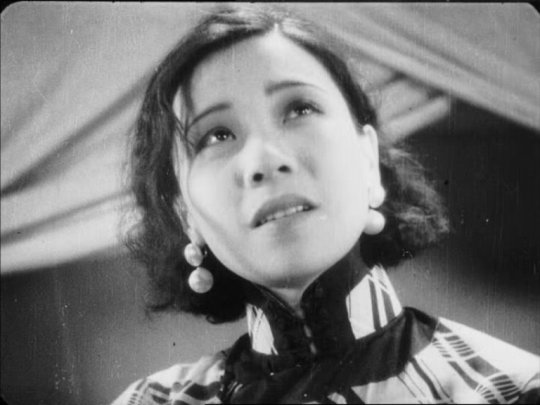
Ruan Lingyu had an eight year movie career, starting at 16 and ending with her suicide at only 24. Despite this, she made some of the most widely acclaimed films of early Chinese cinema and the BBC called her "China's Greta Garbo." In "Love and Duty," she plays her character as a teen, a young mother, and an older woman beaten down by life AND her teen daughter in an early application of split-screen technology. Lingyu is absolutely unrecognizable as the older woman, yet emotionally the transition is seamless because she does such a good job. Lingyu had a hard life and killed herself after ination [sic] of media scorn and private problems. Her funeral was three days long, the procession was allegedly four miles long, and three women killed themselves during her funeral. The New York Times called it "the most spectacular funeral of the century." I'm adding this to show what kind of hold she had over the public at the time, much like Rudolph Valentino's raucous funeral. I would rather she had lived.
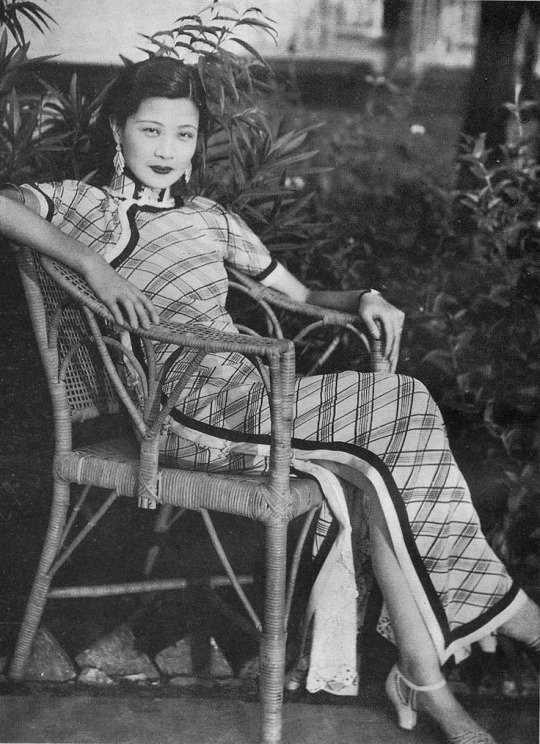
Barbara Stanwyck:

"THE leading lady of the golden age of hollywood. One of the only actresses to work independent of a studio, making short-term contracts that enabled her to make movies wherever she wanted. She had so much range, and could act in basically any genre. She's been rumored to be a lesbian literally since she was active in Hollywood; most notable is the rumor that she had a long time on-and-off relationship with famously bi Joan Crawford, her "best friend" for decades (They lived right next door to one another). She also lived with Helen Ferguson, her "live-in publicist" for many years. She was the quintessential femme fatale in Double Indemnity, and really pushed sexual boundaries in her pre-code films like Baby Face, and the famous screwball The Lady Eve, where she plays basically a downlow domme. Allegedly, when a journalist asked her if she was a lesbian, she straight up threw him out of her house. She even played a lesbian in Walk on the Wild Side"
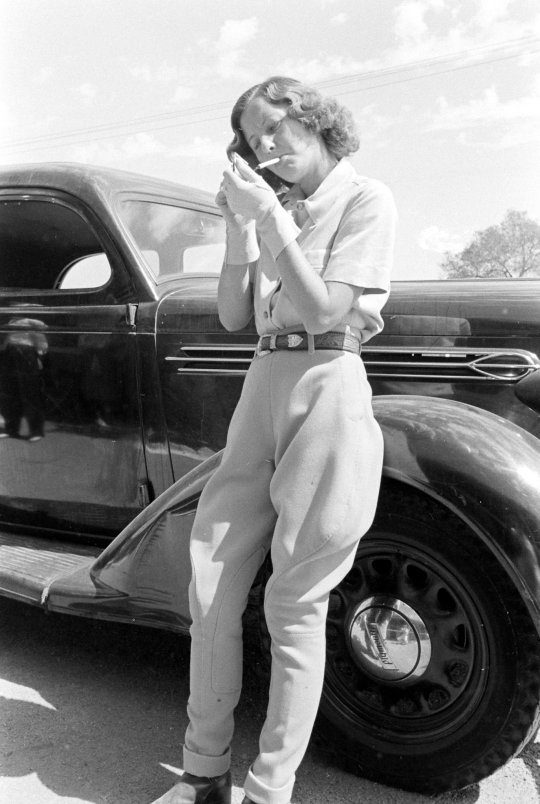

"THE queen of screwball comedies. I adore her, I'd kill for her, I will cry if she's not gonna win this poll."
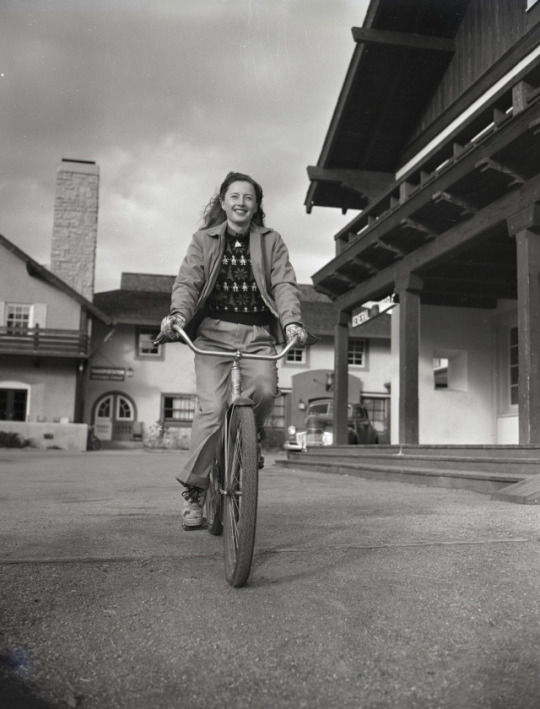
"listen ok she had awful politics she was a mccarthyist right wing wacko BUT she's so incredibly hot that i've deluded myself into believing i could fix her. if you see her onscreen she carries herself in a way that's just so effortlessly sexy AND she has just a stunning face. imo she was at her hottest in the 1940s but even as early as the late 1920s she had a rly captivating screen presence and just a beautiful face, and then post-1950 she was just irresistibly milfy so really she was just always incredibly hot. she was also an incredibly talented actress who was equally stellar in melodrama, film noir, and unhinged screwball comedy. the blonde wig they made her wear in double indemnity is notoriously silly looking but she still looks sexy in it so that's gotta count for something. i've watched so many terrible movies just for a chance at seeing her that i think her estate should be paying me damages."
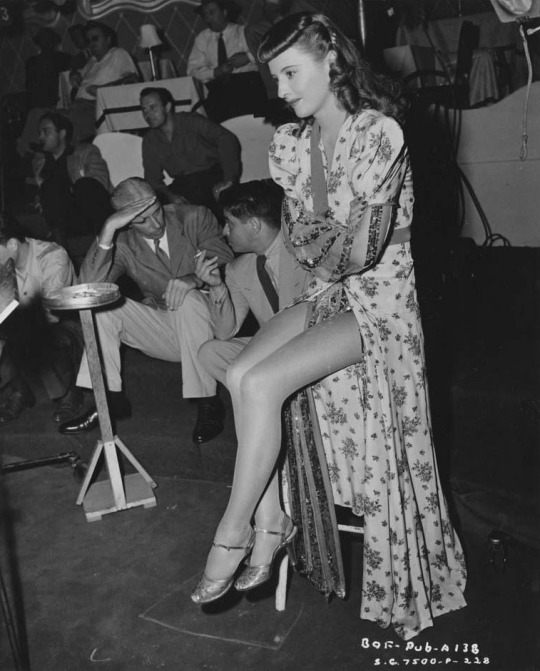
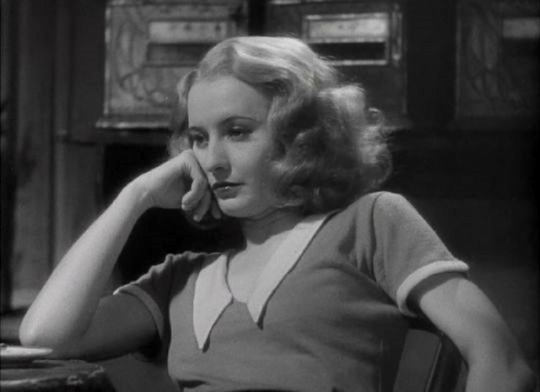
"Not often thought of for her sultriness, Barbara Stanwyck was incredible in that she could actually choose to be hot if the role called for it, and then have a glow-down to look ordinary for another role. She wasn't the most beautiful or effervescent, but damn did she have rizz. Watch her with Gary Cooper in Ball of Fire teaching him about "yum-yum" or with Henry Fonda in The Lady Eve whispering huskily into his ear."
youtube
"She is always the smartest woman in the room. Watching her play Henry Fonda like a befuddled fiddle in The Lady Eve was a highlight of my life. Femme fatale in Double Indemnity, comedy queen in Ball of Fire. She can do anything."
"She was part of my gay awakening"
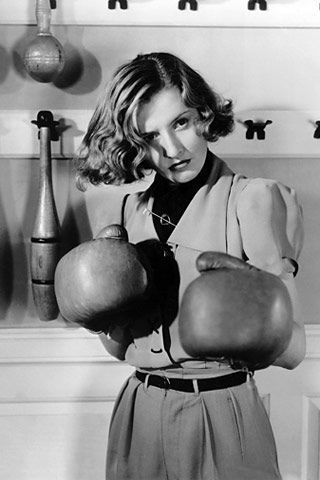
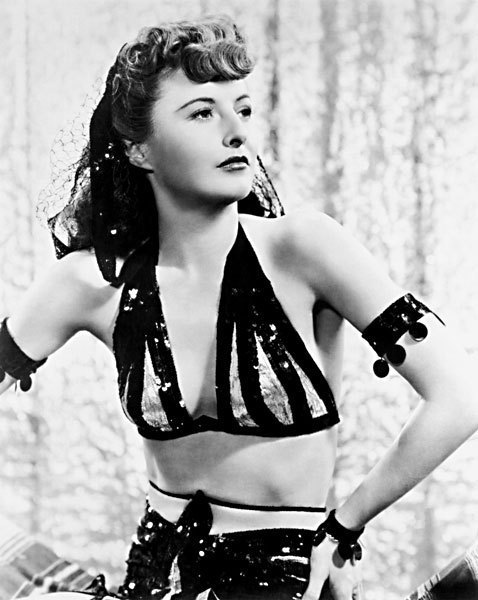

"SHE'S A PRE-CODE QUEEN. She did everything, drama, comedy. The most beautiful woman in the world to watch weep. Beg for to step on you with those legs. Fun Babs story: Ginger Rogers was offered the role in Ball of Fire but said, “Oh, I would never play that part, she’s too common.” So they called Barbara Stanwyck and they said “We offered this to Ginger Rogers but she’s turned it down, would you be interested?” And she read the script and she said; “You bet! I LOVE playing common broads. [link]"

107 notes
·
View notes
Text
Electronic Music History and Today's Best Modern Proponents!
Electronic music history pre-dates the rock and roll era by decades. Most of us were not even on this planet when it began its often obscure, under-appreciated and misunderstood development. Today, this 'other worldly' body of sound which began close to a century ago, may no longer appear strange and unique as new generations have accepted much of it as mainstream, but it's had a bumpy road and, in finding mass audience acceptance, a slow one.
Many musicians - the modern proponents of electronic music - developed a passion for analogue synthesizers in the late 1970's and early 1980's with signature songs like Gary Numan's breakthrough, 'Are Friends Electric?'. It was in this era that these devices became smaller, more accessible, more user friendly and more affordable for many of us. In this article I will attempt to trace this history in easily digestible chapters and offer examples of today's best modern proponents.
To my mind, this was the beginning of a new epoch. To create electronic music, it was no longer necessary to have access to a roomful of technology in a studio or live. Hitherto, this was solely the domain of artists the likes of Kraftwerk, whose arsenal of electronic instruments and custom built gadgetry the rest of us could only have dreamed of, even if we could understand the logistics of their functioning. Having said this, at the time I was growing up in the 60's & 70's, I nevertheless had little knowledge of the complexity of work that had set a standard in previous decades to arrive at this point.
The history of electronic music owes much to Karlheinz Stockhausen (1928-2007). Stockhausen was a German Avante Garde composer and a pioneering figurehead in electronic music from the 1950's onwards, influencing a movement that would eventually have a powerful impact upon names such as Kraftwerk, Tangerine Dream, Brain Eno, Cabaret Voltaire, Depeche Mode, not to mention the experimental work of the Beatles' and others in the 1960's. His face is seen on the cover of "Sgt. Pepper's Lonely Hearts Club Band", the Beatles' 1967 master Opus. Let's start, however, by traveling a little further back in time.
The Turn of the 20th Century
Time stood still for this stargazer when I originally discovered that the first documented, exclusively electronic, concerts were not in the 1970's or 1980's but in the 1920's!
The first purely electronic instrument, the Theremin, which is played without touch, was invented by Russian scientist and cellist, Lev Termen (1896-1993), circa 1919.
In 1924, the Theremin made its concert debut with the Leningrad Philharmonic. Interest generated by the theremin drew audiences to concerts staged across Europe and Britain. In 1930, the prestigious Carnegie Hall in New York, experienced a performance of classical music using nothing but a series of ten theremins. Watching a number of skilled musicians playing this eerie sounding instrument by waving their hands around its antennae must have been so exhilarating, surreal and alien for a pre-tech audience!
For those interested, check out the recordings of Theremin virtuoso Clara Rockmore (1911-1998). Lithuanian born Rockmore (Reisenberg) worked with its inventor in New York to perfect the instrument during its early years and became its most acclaimed, brilliant and recognized performer and representative throughout her life.
In retrospect Clara, was the first celebrated 'star' of genuine electronic music. You are unlikely to find more eerie, yet beautiful performances of classical music on the Theremin. She's definitely a favorite of mine!
Electronic Music in Sci-Fi, Cinema and Television
Unfortunately, and due mainly to difficulty in skill mastering, the Theremin's future as a musical instrument was short lived. Eventually, it found a niche in 1950's Sci-Fi films. The 1951 cinema classic "The Day the Earth Stood Still", with a soundtrack by influential American film music composer Bernard Hermann (known for Alfred Hitchcock's "Psycho", etc.), is rich with an 'extraterrestrial' score using two Theremins and other electronic devices melded with acoustic instrumentation.
Using the vacuum-tube oscillator technology of the Theremin, French cellist and radio telegraphist, Maurice Martenot (1898-1980), began developing the Ondes Martenot (in French, known as the Martenot Wave) in 1928.
Employing a standard and familiar keyboard which could be more easily mastered by a musician, Martenot's instrument succeeded where the Theremin failed in being user-friendly. In fact, it became the first successful electronic instrument to be used by composers and orchestras of its period until the present day.
It is featured on the theme to the original 1960's TV series "Star Trek", and can be heard on contemporary recordings by the likes of Radiohead and Brian Ferry.
The expressive multi-timbral Ondes Martenot, although monophonic, is the closest instrument of its generation I have heard which approaches the sound of modern synthesis.
"Forbidden Planet", released in 1956, was the first major commercial studio film to feature an exclusively electronic soundtrack… aside from introducing Robbie the Robot and the stunning Anne Francis! The ground-breaking score was produced by husband and wife team Louis and Bebe Barron who, in the late 1940's, established the first privately owned recording studio in the USA recording electronic experimental artists such as the iconic John Cage (whose own Avante Garde work challenged the definition of music itself!).
The Barrons are generally credited for having widening the application of electronic music in cinema. A soldering iron in one hand, Louis built circuitry which he manipulated to create a plethora of bizarre, 'unearthly' effects and motifs for the movie. Once performed, these sounds could not be replicated as the circuit would purposely overload, smoke and burn out to produce the desired sound result.
Consequently, they were all recorded to tape and Bebe sifted through hours of reels edited what was deemed usable, then re-manipulated these with delay and reverberation and creatively dubbed the end product using multiple tape decks.
In addition to this laborious work method, I feel compelled to include that which is, arguably, the most enduring and influential electronic Television signature ever: the theme to the long running 1963 British Sci-Fi adventure series, "Dr. Who". It was the first time a Television series featured a solely electronic theme. The theme to "Dr. Who" was created at the legendary BBC Radiophonic Workshop using tape loops and test oscillators to run through effects, record these to tape, then were re-manipulated and edited by another Electro pioneer, Delia Derbyshire, interpreting the composition of Ron Grainer.
As you can see, electronic music's prevalent usage in vintage Sci-Fi was the principle source of the general public's perception of this music as being 'other worldly' and 'alien-bizarre sounding'. This remained the case till at least 1968 with the release of the hit album "Switched-On Bach" performed entirely on a Moog modular synthesizer by Walter Carlos (who, with a few surgical nips and tucks, subsequently became Wendy Carlos).
The 1970's expanded electronic music's profile with the break through of bands like Kraftwerk and Tangerine Dream, and especially the 1980's when it found more mainstream acceptance.
The Mid 1900's: Musique Concrete
In its development through the 1900's, electronic music was not solely confined to electronic circuitry being manipulated to produce sound. Back in the 1940's, a relatively new German invention - the reel-to-reel tape recorder developed in the 1930's - became the subject of interest to a number of Avante Garde European composers, most notably the French radio broadcaster and composer Pierre Schaeffer (1910-1995) who developed a montage technique he called Musique Concrete.
Musique Concrete (meaning 'real world' existing sounds as opposed to artificial or acoustic ones produced by musical instruments) broadly involved the splicing together of recorded segments of tape containing 'found' sounds - natural, environmental, industrial and human - and manipulating these with effects such as delay, reverb, distortion, speeding up or slowing down of tape-speed (varispeed), reversing, etc.
Stockhausen actually held concerts utilizing his Musique Concrete works as backing tapes (by this stage electronic as well as 'real world' sounds were used on the recordings) on top of which live instruments would be performed by classical players responding to the mood and motifs they were hearing!
Musique Concrete had a wide impact not only on Avante Garde and effects libraries, but also on the contemporary music of the 1960's and 1970's. Important works to check are the Beatles' use of this method in ground-breaking tracks like 'Tomorrow Never Knows', 'Revolution No. 9' and 'Being for the Benefit of Mr. Kite', as well as Pink Floyd albums "Umma Gumma", "Dark Side of the Moon" and Frank Zappa's "Lumpy Gravy". All used tape cut-ups and home-made tape loops often fed live into the main mixdown.
Today this can be performed with simplicity using digital sampling, but yesterday's heroes labored hours, days and even weeks to perhaps complete a four minute piece! For those of us who are contemporary musicians, understanding the history of electronic music helps in appreciating the quantum leap technology has taken in the recent period. But these early innovators, these pioneers - of which there are many more down the line - and the important figures they influenced that came before us, created the revolutionary groundwork that has become our electronic musical heritage today and for this I pay them homage!
1950's: The First Computer and Synth Play Music
Moving forward a few years to 1957 and enter the first computer into the electronic mix. As you can imagine, it wasn't exactly a portable laptop device but consumed a whole room and user friendly wasn't even a concept. Nonetheless creative people kept pushing the boundaries. One of these was Max Mathews (1926 -) from Bell Telephone Laboratories, New Jersey, who developed Music 1, the original music program for computers upon which all subsequent digital synthesis has its roots based. Mathews, dubbed the 'Father of Computer Music', using a digital IBM Mainframe, was the first to synthesize music on a computer.
In the climax of Stanley Kubrik's 1968 movie '2001: A Space Odyssey', use is made of a 1961 Mathews' electronic rendition of the late 1800's song 'Daisy Bell'. Here the musical accompaniment is performed by his programmed mainframe together with a computer-synthesized human 'singing' voice technique pioneered in the early 60's. In the movie, as HAL the computer regresses, 'he' reverts to this song, an homage to 'his' own origins.
1957 also witnessed the first advanced synth, the RCA Mk II Sound Synthesizer (an improvement on the 1955 original). It also featured an electronic sequencer to program music performance playback. This massive RCA Synth was installed, and still remains, at the Columbia-Princeton Electronic Music Center, New York, where the legendary Robert Moog worked for a while. Universities and Tech laboratories were the main home for synth and computer music experimentation in that early era.
1960's: The Dawning of The Age of Moog
The logistics and complexity of composing and even having access to what were, until then, musician unfriendly synthesizers, led to a demand for more portable playable instruments. One of the first to respond, and definitely the most successful, was Robert Moog (1934-2005). His playable synth employed the familiar piano style keyboard.
Moog's bulky telephone-operators' cable plug-in type of modular synth was not one to be transported and set up with any amount of ease or speed! But it received an enormous boost in popularity with the success of Walter Carlos, as previously mentioned, in 1968. His LP (Long Player) best seller record "Switched-On Bach" was unprecedented because it was the first time an album appeared of fully synthesized music, as opposed to experimental sound pieces.
The album was a complex classical music performance with various multi-tracks and overdubs necessary, as the synthesizer was only monophonic! Carlos also created the electronic score for "A Clockwork Orange", Stanley Kubrik's disturbing 1972 futuristic film.
From this point, the Moog synth is prevalent on a number of late 1960's contemporary albums. In 1967 the Monkees' "Pisces, Aquarius, Capricorn & Jones Ltd" became the first commercial pop album release to feature the modular Moog. In fact, singer/drummer Mickey Dolenz purchased one of the very first units sold.
It wasn't until the early 1970's, however, when the first Minimoog appeared that interest seriously developed amongst musicians. This portable little unit with a fat sound had a significant impact becoming part of live music kit for many touring musicians for years to come. Other companies such as Sequential Circuits, Roland and Korg began producing their own synths, giving birth to a music subculture.
I cannot close the chapter on the 1960's, however, without reference to the Mellotron. This electronic-mechanical instrument is often viewed as the primitive precursor to the modern digital sampler.
Developed in early 1960's Britain and based on the Chamberlin (a cumbersome US-designed instrument from the previous decade), the Mellotron keyboard triggered pre-recorded tapes, each key corresponding to the equivalent note and pitch of the pre-loaded acoustic instrument.
The Mellotron is legendary for its use on the Beatles' 1966 song 'Strawberry Fields Forever'. A flute tape-bank is used on the haunting introduction played by Paul McCartney.
The instrument's popularity burgeoned and was used on many recordings of the era such as the immensely successful Moody Blues epic 'Nights in White Satin'. The 1970's saw it adopted more and more by progressive rock bands. Electronic pioneers Tangerine Dream featured it on their early albums.
With time and further advances in microchip technology though, this charming instrument became a relic of its period.
1970's: The Birth of Vintage Electronic Bands
The early fluid albums of Tangerine Dream such as "Phaedra" from 1974 and Brian Eno's work with his self-coined 'ambient music' and on David Bowie's "Heroes" album, further drew interest in the synthesizer from both musicians and audience.
Kraftwerk, whose 1974 seminal album "Autobahn" achieved international commercial success, took the medium even further adding precision, pulsating electronic beats and rhythms and sublime synth melodies. Their minimalism suggested a cold, industrial and computerized-urban world. They often utilized vocoders and speech synthesis devices such as the gorgeously robotic 'Speak and Spell' voice emulator, the latter being a children's learning aid!
While inspired by the experimental electronic works of Stockhausen, as artists, Kraftwerk were the first to successfully combine all the elements of electronically generated music and noise and produce an easily recognizable song format. The addition of vocals in many of their songs, both in their native German tongue and English, helped earn them universal acclaim becoming one of the most influential contemporary music pioneers and performers of the past half-century.
Kraftwerk's 1978 gem 'Das Modell' hit the UK number one spot with a reissued English language version, 'The Model', in February 1982, making it one of the earliest Electro chart toppers!
Ironically, though, it took a movement that had no association with EM (Electronic Music) to facilitate its broader mainstream acceptance. The mid 1970's punk movement, primarily in Britain, brought with it a unique new attitude: one that gave priority to self-expression rather than performance dexterity and formal training, as embodied by contemporary progressive rock musicians. The initial aggression of metallic punk transformed into a less abrasive form during the late 1970's: New Wave. This, mixed with the comparative affordability of many small, easy to use synthesizers, led to the commercial synth explosion of the early 1980's.
A new generation of young people began to explore the potential of these instruments and began to create soundscapes challenging the prevailing perspective of contemporary music. This didn't arrive without battle scars though. The music industry establishment, especially in its media, often derided this new form of expression and presentation and was anxious to consign it to the dustbin of history.
1980's: The First Golden Era of Electronic Music for the Masses
Gary Numan became arguably the first commercial synth megastar with the 1979 "Tubeway Army" hit 'Are Friends Electric?'. The Sci-Fi element is not too far away once again. Some of the imagery is drawn from the Science Fiction classic, "Do Androids Dream of Electric Sheep?". The 1982 hit film "Blade Runner" was also based on the same book.
Although 'Are Friends Electric?' featured conventional drum and bass backing, its dominant use of Polymoogs gives the song its very distinctive sound. The recording was the first synth-based release to achieve number one chart status in the UK during the post-punk years and helped usher in a new genre. No longer was electronic and/or synthesizer music consigned to the mainstream sidelines. Exciting!
Further developments in affordable electronic technology placed electronic squarely in the hands of young creators and began to transform professional studios.
Designed in Australia in 1978, the Fairlight Sampler CMI became the first commercially available polyphonic digital sampling instrument but its prohibitive cost saw it solely in use by the likes of Trevor Horn, Stevie Wonder and Peter Gabriel. By mid-decade, however, smaller, cheaper instruments entered the market such as the ubiquitous Akai and Emulator Samplers often used by musicians live to replicate their studio-recorded sounds. The Sampler revolutionized the production of music from this point on.
In most major markets, with the qualified exception of the US, the early 1980's was commercially drawn to electro-influenced artists. This was an exciting era for many of us, myself included. I know I wasn't alone in closeting the distorted guitar and amps and immersing myself into a new universe of musical expression - a sound world of the abstract and non traditional.
At home, Australian synth based bands Real Life ('Send Me An Angel', "Heartland" album), Icehouse ('Hey Little Girl') and Pseudo Echo ('Funky Town') began to chart internationally, and more experimental electronic outfits like Severed Heads and SPK also developed cult followings overseas.
But by mid-decade the first global electronic wave lost its momentum amidst resistance fomented by an unrelenting old school music media. Most of the artists that began the decade as predominantly electro-based either disintegrated or heavily hybrid their sound with traditional rock instrumentation.
The USA, the largest world market in every sense, remained in the conservative music wings for much of the 1980's. Although synth-based records did hit the American charts, the first being Human League's 1982 US chart topper 'Don't You Want Me Baby?', on the whole it was to be a few more years before the American mainstream embraced electronic music, at which point it consolidated itself as a dominant genre for musicians and audiences alike, worldwide.
1988 was somewhat of a watershed year for electronic music in the US. Often maligned in the press in their early years, it was Depeche Mode that unintentionally - and mostly unaware - spearheaded this new assault. From cult status in America for much of the decade, their new high-play rotation on what was now termed Modern Rock radio resulted in mega stadium performances. An Electro act playing sold out arenas was not common fare in the USA at that time!
In 1990, fan pandemonium in New York to greet the members at a central record shop made TV news, and their "Violator" album outselling Madonna and Prince in the same year made them a US household name. Electronic music was here to stay, without a doubt!
1990's Onward: The Second Golden Era of Electronic Music for the Masses
Before our 'star music' secured its hold on the US mainstream, and while it was losing commercial ground elsewhere throughout much of the mid 1980's, Detroit and Chicago became unassuming laboratories for an explosion of Electronic Music which would see out much of the 1990's and onwards. Enter Techno and House.
Detroit in the 1980's, a post-Fordism US industrial wasteland, produced the harder European influenced Techno. In the early to mid 80's, Detroiter Juan Atkins, an obsessive Kraftwerk fan, together with Derrick May and Kevin Saunderson - using primitive, often borrowed equipment - formed the backbone of what would become, together with House, the predominant music club-culture throughout the world. Heavily referenced artists that informed early Techno development were European pioneers such as the aforementioned Kraftwerk, as well as Yello and British Electro acts the likes of Depeche Mode, Human League, Heaven 17, New Order and Cabaret Voltaire.
Chicago, a four-hour drive away, simultaneously saw the development of House. The name is generally considered to be derived from "The Warehouse" where various DJ-Producers featured this new music amalgam. House has its roots in 1970's disco and, unlike Techno, usually has some form of vocal. I think Giorgio Moroder's work in the mid 70's with Donna Summer, especially the song 'I Feel Love', is pivotal in appreciating the 70's disco influences upon burgeoning Chicago House.
A myriad of variants and sub genres have developed since - crossing the Atlantic, reworked and back again - but in many ways the popular success of these two core forms revitalized the entire Electronic landscape and its associated social culture. Techno and House helped to profoundly challenge mainstream and Alternative Rock as the preferred listening choice for a new generation: a generation who has grown up with electronic music and accepts it as a given. For them, it is music that has always been.
The history of electronic music continues to be written as technology advances and people's expectations of where music can go continues to push it forward, increasing its vocabulary and lexicon.
Related Site study music
0 notes
Text
Lithuania's dress is really beautiful, she looks like an early 1920's cinema star, I love her
1 note
·
View note